

The Three Questions You Should Ask to Think More Critically. UVU: Presidential Lecture Series - Sir Ken Robinson. New Report: Technology Can Close Achievement Gaps and Improve Learning Outcomes for At-Risk Students. Press Release: New Report: Technology Can Close Achievement Gaps and Improve Learning Outcomes for At-Risk Students Report Identifies Key Strategies to Successful Technology Implementation WASHINGTON, DC – As school districts around the country consider investing in technology as a way to improve student outcomes, a new report from the Alliance for Excellent Education and the Stanford Center for Opportunity Policy in Education (SCOPE) finds that technology—when implemented properly—can produce significant gains in student achievement and boost engagement, particularly among students most at risk.

“This report makes clear that districts must have a plan in place for how they will use technology before they make a purchase,” said Bob Wise, president of the Alliance for Excellent Education and former governor of West Virginia. “It also underscores that replacing teachers with technology is not a successful formula. Nine of the Best Ways to Boost Creative Thinking. When it comes to creativity, one of our biggest concerns is usually how we can be more creative, or how to come up with better ideas.
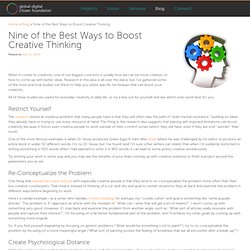
Research in this area is all over the place, but I’ve gathered some of the most practical studies out there to help you utilize specific techniques that can boost your creativity. All of these studies are useful for everyday creativity in daily life, so try a few out for yourself and see which ones work best for you. Restrict Yourself The research shows an insidious problem that many people have is that they will often take the path of “least mental resistance,” building on ideas they already have or trying to use every resource at hand. The thing is, the research also suggests that placing self-imposed limitations can boost creativity because it forces even creative people to work outside of their comfort zones (which they still have, even if they are a bit “weirder” than most). One of the most famous examples is when Dr.
How to Take Criticism Well - WSJ. Do Less Of This & More Of This In Your School Staff Meeting. Boring School Staff Meeting?
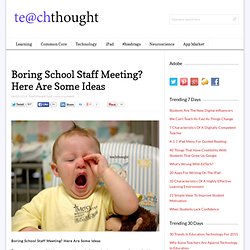
Here Are Some Ideas For many of us, snow did this to us—pushing end-of-the-school-year proceedings until mid to late June. We’ll probably be brought back in a few times in July, at which point it’ll be time to get our 2014-2015 rosters for a new school year. That makes right now a delicate time. Here are some tips that as a teacher you can use to–well, these probably won’t help you.
For all 3 of you, here are some ideas. Educational Technology and Mobile Learning: What Teachers Can learn from Inside Google Garage. Google's secret of success is not so much in the services and apps it produces but resides deep within the intricate social texture that ties together all of its workers.

It is hard to get to the top and become the first search engine in the world but it is way harder to keep being at the top. There is an ongoing fierce competition from other search engines and companies to dethrone Google and take its place but all in vain. Google has the magic recipe that no other company has ever had: it is a genuine investment in the human capital, that is what Google does the best.
Google workers work in teams and use their collective wisdom to push their inventions a step further. Creativity, Curriculum, and Digital Age Learning - Connecting to Literature i... Creativity, Curriculum, and Digital Age Learning - Connecting to Literature in Math Posted by Melinda Kolk on Fri, May 18, 2012 @ 02:28 PM In an earlier post, I talked about the importance of the 4 C's (creativity, collaboration, critical thinking, and communication) as well as the 3 R's in preparing students for life in the digital age.
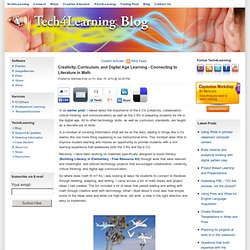
All to often technology skills, as well as curriculum standards, are taught as a discrete set of skills.
BLIG-2.0-Final-Paper. Deeper Learning: Defining Twenty-First Century Literacy. Critical Thinking Via Infographics 21st Century Fluency Project. Innovative Learning Environments - Books. Innovative Education: Mathematics Online: Learning Maths Innovative. Mathematics is a subject where exercises’ play a great role in learning.
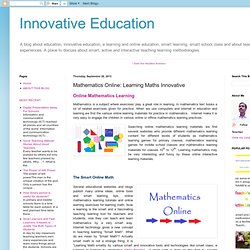
In mathematics text books a lot of related exercises given for practice. Leading Innovative Change Series – Learning First, Technology Second. I wanted to try my hand at writing a series of blog posts on “Leading Innovative Change”.
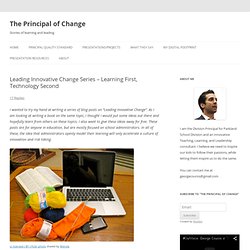
As I am looking at writing a book on the same topic, I thought I would put some ideas out there and hopefully learn from others on these topics. Solve for X. Leading Innovative Change Series – A New Staff Experience. Ten Takeaway Tips for Teaching Critical Thinking. Suggestions from educators at KIPP King Collegiate High School on how to help develop and assess critical-thinking skills in your students.
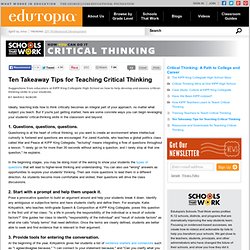
Ideally, teaching kids how to think critically becomes an integral part of your approach, no matter what subject you teach. But if you're just getting started, here are some concrete ways you can begin leveraging your students' critical-thinking skills in the classroom and beyond. 1. Questions, questions, questions. Questioning is at the heart of critical thinking, so you want to create an environment where intellectual curiosity is fostered and questions are encouraged. In the beginning stages, you may be doing most of the asking to show your students the types of questions that will lead to higher-level thinking and understanding. 2.
Pose a provocative question to build an argument around and help your students break it down. 3. 4. 5. Lively discussions usually involve some degree of differing perspectives. 6. 7. 8. 9. Resources and Downloads for Teaching Critical Thinking. Tips for downloading: PDF files can be viewed on a wide variety of platforms -- both as a browser plug-in or a stand-alone application -- with Adobe's free Acrobat Reader program.
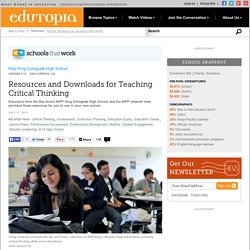
Click here to download the latest version of Adobe Reader. Click on any title link below to view or download that file. Training Teachers to Teach Critical Thinking. How KIPP educators instruct their colleagues to enhance their classroom practice.

KIPP King Collegiate High School principal Jason Singer trains his teachers to lead Socratic discussions (above); Katie Kirkpatrick (right), dean of instruction, developed a step-by-step framework -- described below -- for teaching students basic critical-thinking skills. Credit: Zachary Fink Thinking critically is one thing, but being able to teach it can be quite another. Katie Kirkpatrick, dean of instruction at KIPP King Collegiate High School, developed the school's Speech & Composition class, a requirement for all students. Express 6.04 - 10 Essential Strategies for Teaching Boys Effectively.
Initiative, Connection and Challenge: Hexagonal Learning. For literacy this term our intermediate school has been learning and discovering all about significant moments in history. In particular, one of the main focuses has been racism and civil rights. As a whole, the students have been examining the impact of Martin Luther King, Nelson Mandela, Rosa Parks and even Michael Jackson’s influence on race relations through song. The learning, overall, has been powerful and the students have been strongly engaged with the content. I’ve been thinking about thinking and reading more and more about hexagonal learning - via Chris Harte in particular. This model seems simple to implement, yet a fabulous means for getting the students to discuss, justify and even argue.
As an introduction to this way of organising ideas and thinking, I took our topic of civil rights and racial inequality and put together 20 hexagons with a variety of words and phrases. Not one student asked me if they were doing it right! Write a Great Authentic Task. Project-based Learning engages students in projects that allow them to construct their own knowledge and develop authentic products while dealing with real-world issues. In order to challenge students on this level, it is helpful to frame their work with an authentic task. Authentic tasks require students to demonstrate proficiency by applying existing knowledge to solve a real-world problem.
Authentic tasks create a bridge between what is learned in the classroom and why this knowledge is important to the world outside of the classroom. Authentic tasks are not meant to replace current classroom practice, but to provide another strategy to meet learning goals and measure student understanding. What does an authentic task look like? Immigration Station In the past four years, your city has had an influx of over 10,000 immigrants.
Your task force will make a 15 minute presentation of what needs to be done. 30 Incredible Ways Technology Will Change Education By 2028. Assessing 21st Century Skills. Recently, one of the teachers who is participating in our district’s 21st Century Learning grant project came to talk with me about assessing 21 century skills – one of the expectations for teachers in this project. Her observation was that students frequently practice the skills when engaged in research or project based learning. The thing she was struggling, with, though, was how to “grade it.” Assessing skills like collaboration, information literacy, creativity, self-direction, and critical thinking seems like a difficult. The Vision K-20 Evidence. Project-Based Learning Research: Annotated Bibliography. Project-Based Learning Research: Annotated Bibliography.